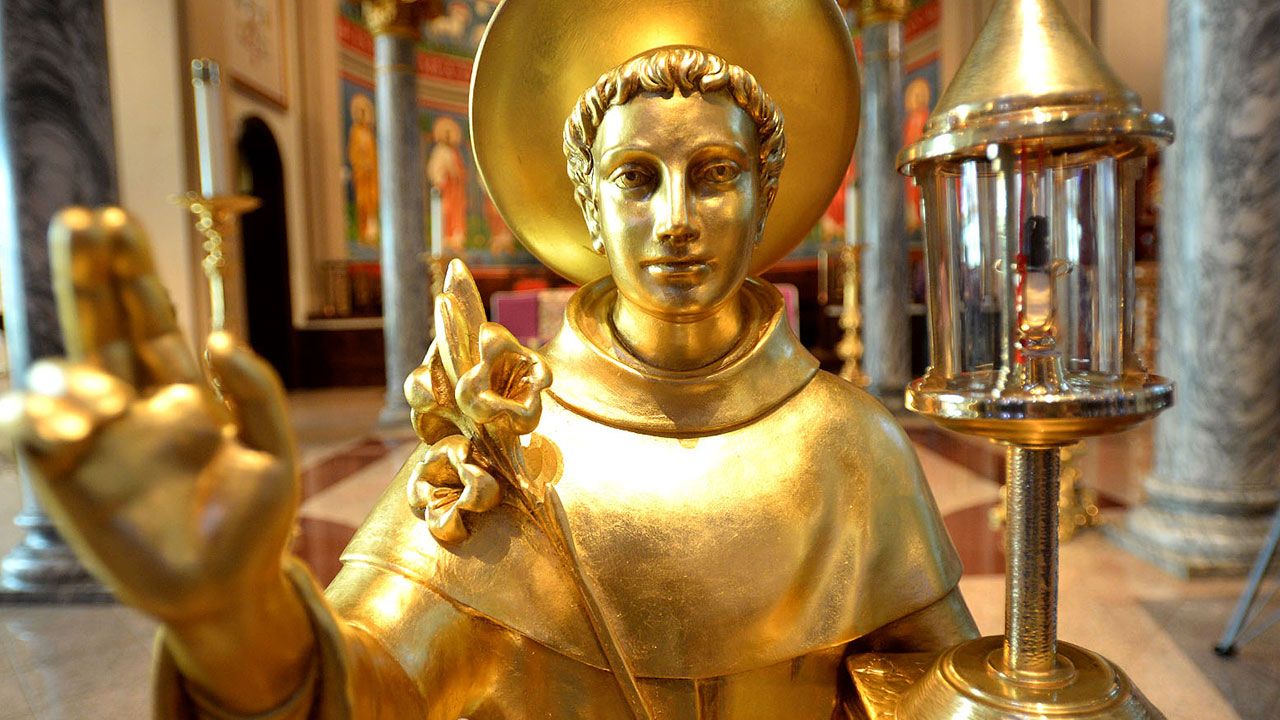
History of Saint Anthony of Padua
Content translated by Google Translate

History of Saint Anthony of Padua
Santo Antônio de Padua, was born in Lisbon, Portugal, on August 15, 1,195, was baptized Fernando de Bulhoes, descendant of the family of Godofredo de Bulhoes, head of the first crusade of the 11th century. He was the eldest of a noble, powerful, and wealthy family. The parents sent him to his studies, wanting him to become a magistrate or a bishop. But early on, he began to disillusion his parents' ambitious mirages. God attracted him and he didn't resist. He loved prayer intensely. A picturesque legend tells that one day, in the cathedral of Lisbon, while praying, the boy chased away the devil by tracing the sign of the cross on the ground.
At the age of 15, he leaves his rich palace, his family, who are against him, and goes to lock up in the abbey of São Vicente, on the outskirts of Lisbon, which belongs to the Canons Regular of Santo Agostinho. It is to these religious that Fernando owes all his intellectual training, which makes him one of the most cultured men in the Church in Europe at the beginning of the 12th century.
Shortly thereafter, he was transferred to another abbey, the Monastery of Santa Cruz, in Coimbra, which was the capital of the kingdom of Portugal.
At 25, he was still an Augustinian ordained a priest. This year Santo Antônio had the great turn in the axis of its history: It is common agreement that in the same year he passes from Canon Regular Augustinian to follow in the footsteps of a new founder: Francisco de Assis. There are three reasons that influenced the change of order: a) the stagnation of his congregation and the lack of its apostolic spirit and idealism; b) the new order that was being born was on its “honeymoon”; full of vigor and idealism, these friars adopted the essential elements of traditional religious life, but withdrew from it in several aspects: they had no monasteries, no fixed residences, or economic security, as they professed absolute poverty in common and in particular, they dedicated themselves to missionary activity with pretensions of conquering the world for Jesus Christ; c) the five Franciscan martyrs murdered in Morocco whose bodies were brought to Coimbra and, by coincidence, to the same monastery of Santa Cruz, where Santo Antônio lived. They narrate the old biographies that, at the time, Fernando, driven by the desire to imitate the heroism of the friars, asked to join the new order.
When receiving the Franciscan burel, Fernando also leaves behind his old name, welcoming another one: Antônio, that is, Frei Antônio. It received this name from the patron saint of the convent of the Friars Minor in Coimbra, which in those times was common to give a new name to all those who entered the Order. The word Antônio means "sounding" (that thunders in the heights, resounding, thunderous, thunderous: that sounds loud, thunderous) "as foreshadowing, as the first biographer of the Santo Antônio caption writes - or assiduously, how great herald of the word of God would be. Indeed, when he spoke among the perfects of God's wisdom hidden in the mystery such and such profound things of Scripture as a loud trumpet that "sounded" his voice, even one who was accustomed to interpreting the Scriptures could rarely understand the that his tongue explained” (Assidua, 12).
At the end of the same year (1220) he goes to Morocco, where he intends to fulfill his missionary dream. But he gets sick and needs to go back. Already somewhat recovered, he traveled to Assisi to take part in the Chapter of Mats (Pentecost of 1221) and there he had his first meeting with St. Francis. After the General Chapter, the Portuguese friar went to live in the hermitage of Monte-Paolo, near Forli, in the province of Romagna. As a light under a vessel, on the occasion of a priestly ordination, the oratory gift of Friar Antonio, who until then only took care of the kitchen and the vegetable garden, was revealed. His future activity would thus take shape, predominantly devoted to popular preaching, alongside the theological magisterium and the direction of communities of friars.
In the "Sermons", St. Anthony spoke about prayer as a relationship of love, which leads man to talk to the Lord, creating a joy that involves the soul in prayer. Antônio reminds us that prayer needs an atmosphere of silence, which does not coincide with the removal of external noise, but is an interior experience, which seeks to avoid the distractions caused by the concerns of the soul. For St. Anthony, prayer is composed of four indispensable attitudes that, in Latin, are defined as: obsecratio, oratio, postulatio, gratiarum actio. We could translate them like this: opening our hearts with confidence to God, conversing affectionately with Him, presenting our needs, praising and thanking Him.
